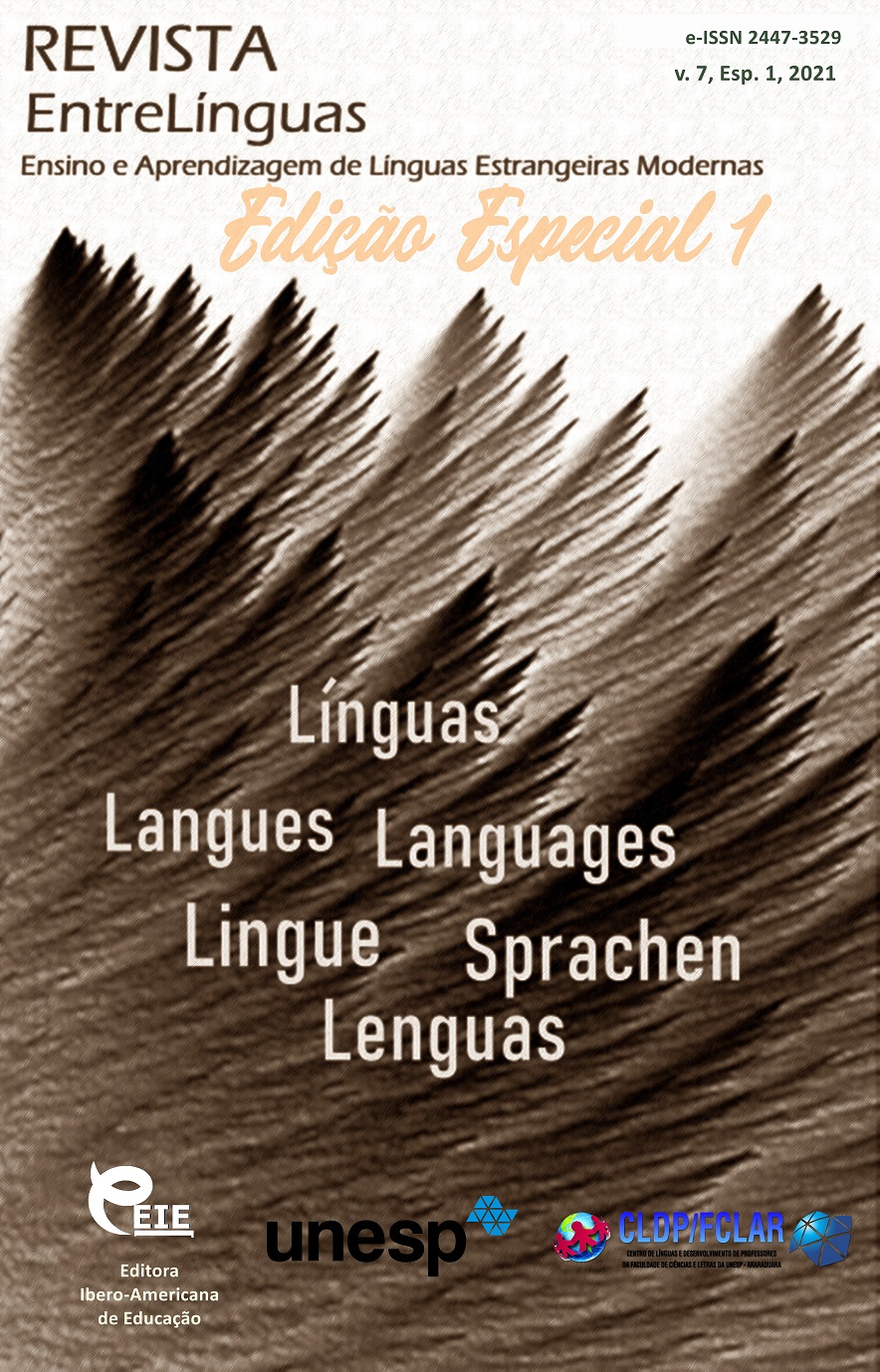Regarding the issue of specificity of A.I Vvedensky's language
DOI:
https://doi.org/10.29051/el.v7iEsp1.14886Keywords:
World of contradiction, Words-hieroglyphs, Methods of language-game, TransformationsAbstract
The object of analysis in the provided article is the language-game as a method of representing the author’s vision. The content behind term “language-game” is revealed by an art space of A.I. Vvedensky, Russian poet of avant-gardism and philosopher. It is analyzed a distinction between children’s and adult’s works. The main content of the current study is an analysis of the most effective methods of language-game presentation in artistic communication of the poet, such as free verse, contamination of phraseological units, comparison, semantic indifference of lexemes, transformation of grammar categories, phrase deformation, etc. Based on the conducted research, a conclusion about specifics of the poet’s individual writing style can be made. In Vvedensky’s linguistic poetics, language-game manifests itself at different levels of text function as an important factor to text formation. It is important to note that language-game techniques found in his children’s works are aimed at building a positive dialog and are seen as a positive phenomenon, while his more mature works feature an abstract artistic world with abstract artistic meaning.
Downloads
References
BIDERKESEN D.; AGEEVA J.V.; SEVINC U. Military Vocabulary as a Special Element of a Language Lexical System. Jour of Adv Research in Dynamical & Control Systems, v. 11, n. 08, р. 467-470, 2019.
DRUSKIN, Y. S. Zvezda bessmyslicy. «Sborishche druzej, ostavlennyh sud'boyu» In: VEDENSKIJ, A. V.; LIPAVSKIJ, L.; DRUSKIN, Y. A.; HARMS, D.; OLEJNIKOV, N. «chinari» v tekstah, dokumentah i issledovaniyah. Moscow: Ladomir, 2000. v. 1, p. 846.
EROFEEVA, I. V.; GIMATOVA, L. I.; SERGEEVA, E. V. Modeling of the lexico-semantic field «intellect» in the Russian translation of Herman Hesse’s novel «Steppenwolf». Modern Journal of Language Teaching Methods (MJLTM), v. 8, n. 9, p. 54-59, 2018.
GRIDINA, T.A. Associativnyj potencial slova i ego realizaciya v rechi. Yavlenie yazykovoj igry [Associative potential of word and its realization in speech. Language-game phenomenon]: dissertation of the candidate of philological sciences. Moscow, 1996. p. 566.
NIKOLINA, N. A.; AGEEVA, E. A. Yazykovaya igra v sovremennoj russkoj proze” // Russkij yazyk segodnya. Мoscow, n. 1., p. 551-561, 2000.
SAFIN, I. C. H.; KOLOSOVA, E. I.; GIMRANOVA, T. A. Interpretation of an Epoch in the Novel the Big Green Tent by L. Ulitskaya: Linguistic-Cultural Analysis of Verbal Lexicon. Tarih Kultur ve Sanat Arastirmalari Dergisi-Journal of History Culture and Art Research, v. 6, n. 5, p. 116-121, 2017.
SHTYRLINA, E. G.; ANTROPOVA, M. Y. Semantics of the artistic image of the moon in K. Balmont's poetry. Amazonia Investiga, v. 7, n. 13, p. 233-238, 2018.
SPIRIDONNOV, A. V.; KHABIBULLINA, E. V. Occasional derivation as a way of era language stylization in v. aksyonov's novel" voltairiens and voltairiennes. Journal of Language and Literature, v. 7, n. 1, p. 219-222, 2016.
STAROSTINA, O. V.; BOCHINA, T. G.; LARIONOVA, E. S. Archetype of water in the Silver Age poetry. In: INERNATIONAL MULTIDISCIPLINARYSCIENTIFIC CONFERENCE ON SOCIAL SCIENCES & ARTS, 4., 2017. Proceedings […]. SGEM, 2017. v. 2, p. 579-585.
VALIEVA YU. M. Igra v bessmyslicu [A game of nonsense]. 2016. Available: http://literary.ru/literary.ru/readme.php. Access: 10 dec. 2020.
WITTGENSTEIN, L. Filosofskie issledovaniya. Filosofskie raboty. Мoscow: Gnozis, 1994. v. 1, p. 612
ZEMSKAYA E. A.; KITAJGORODSKAYA M. V.; ROZANOVA N. I. Yazykovaya igra” // Russkaya razgovornaya rech': Fonetika. Morfologiya. Leksika. ZHest. Moscow: Nauka, , 1983. p. 172-214.
Downloads
Published
How to Cite
Issue
Section
License

This work is licensed under a Creative Commons Attribution-NonCommercial-ShareAlike 4.0 International License.
Os manuscritos aceitos e publicados são de propriedade da Revista EntreLínguas. Os artigos publicados e as referências citadas na Revista EntreLínguas são de inteira responsabilidade de seus autores.
Transferência de direitos autorais – autorização para publicação
Caso o artigo submetido seja aprovado para publicação, já fica acordado que o(s) autor(es) autoriza(m) a UNESP a reproduzi-lo e publicá-lo na EntreLínguas, entendendo-se os termos “reprodução” e “publicação” conforme definição respectivamente dos incisos VI e I do artigo 5° da Lei 9610/98. O artigo poderá ser acessado pela rede mundial de computadores (Internet), sendo permitidas, a título gratuito, a consulta e a reprodução de exemplar do artigo para uso próprio de quem a consulta, desde que haja a citação ao texto consultado. Essa autorização de publicação 328 EntreLínguas, Araraquara, v. 1, n .2, p. 323-328, jul./dez. 2015 não tem limitação de tempo, ficando a UNESP responsável pela manutenção da identificação do(s) autor(es) do artigo. Os artigos publicados e as referências citadas na Revista EntreLínguas são de inteira responsabilidade de seus autores.











